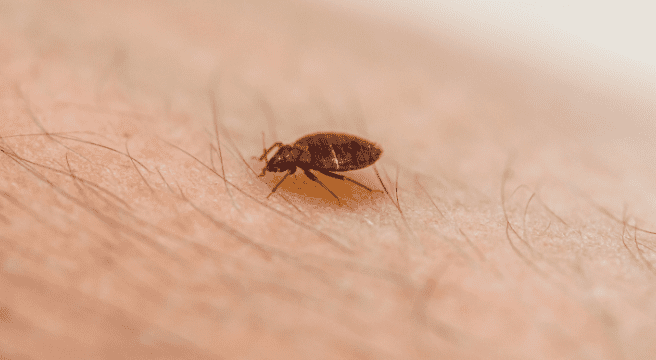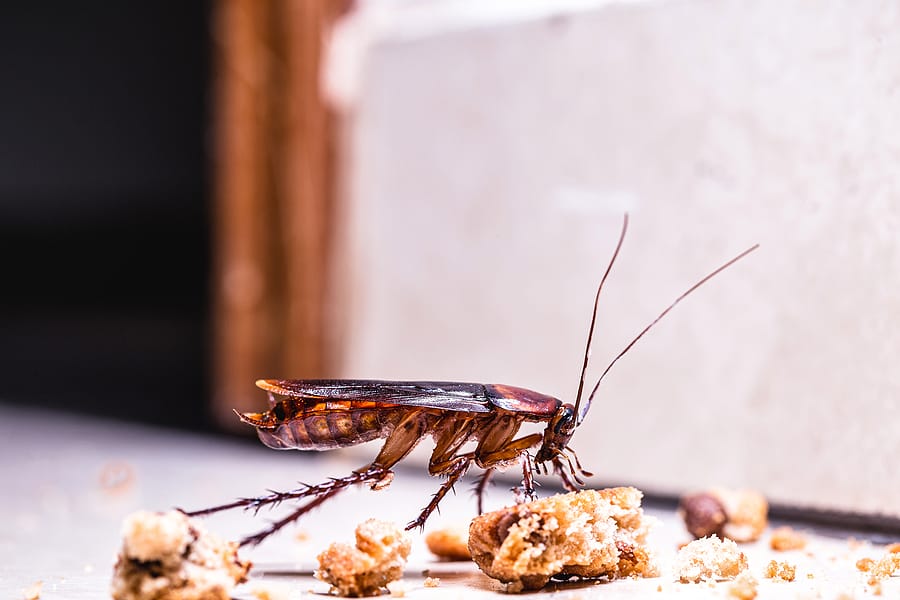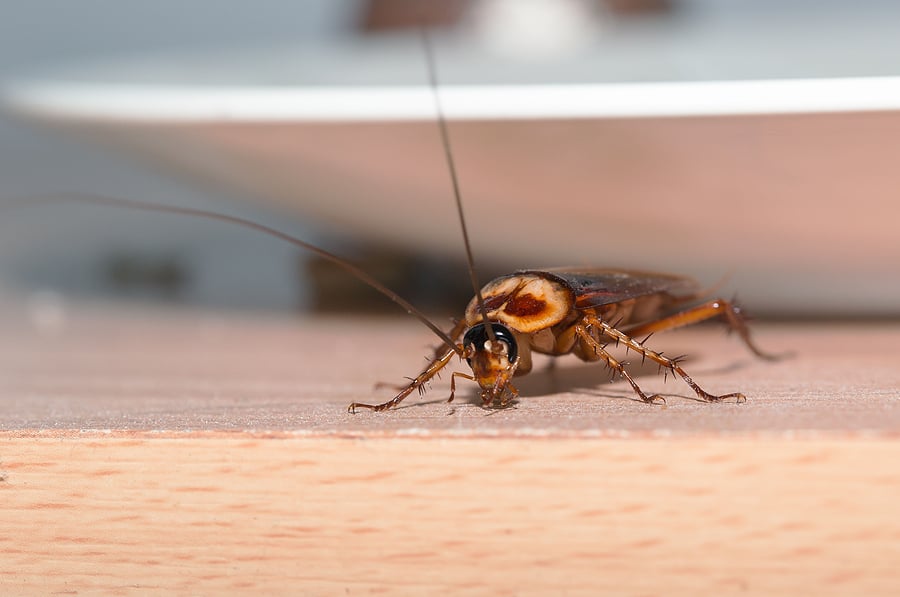READY TO GET STARTED?
REQUEST A FREE ESTIMATE
Fill out the form below or call (888) 466-7849 for a free, no-obligation estimate.

The old saying “don’t let the bed bugs bite” shouldn’t instill fear into your nighttime sleep. These fearsome insects bring itchy bites, crawling hordes, and ruined furniture. Bed bugs are one of the most difficult pests to get rid of. Identifying them and acting quickly is the first step in your plan of action. Let’s break down the basics of bed bugs and discover what to do if you suspect you have a bed bug infestation.
If you’re waking up finding mosquito-like bites all over, then that can be a tell-tale sign that you have bed bugs. But what does the culprit look like? Bed bugs are tiny, appleseed-sized insects. They are flat and oval-shaped with horizontal ridges across their bodies. Bed bugs don’t have wings, but they are extremely fast movers. Adult bed bugs are visible to the human eye and can be detected by sight. Bed bug nymphs can be harder to identify, as they are smaller in size and paler in color.
Bed bugs are notorious hitchhikers, allowing them to travel long distances. They latch onto suitcases, clothes, and linens, ending up wherever these items are taken. Therefore, the spread of bed bugs comes easily. A common place that bed bugs are found is in hotel rooms. It’s important to lookout for bed bugs when visiting a hotel. Before sleeping, thoroughly inspect hotel beds and pillows. Since they tend to travel easily, be sure to vacuum suitcases and inspect for any signs of bed bugs upon returning from a vacation.
If you have confirmed that you have bed bugs, you’ll want to act fast to get rid of them. Try a combination of these methods: heat and chemicals. This is considered one of the best ways to get rid of bed bugs. Bed bugs don’t like hot temperatures, so throwing items infested by bed bugs in the dryer on high heat for 20 minutes will remove them. If you travel often, you may want to start doing this with your belongings when you return home.
While throwing affected items in the dryer is an excellent choice to eliminate them, it doesn’t address a larger infestation, and it won’t find them in all their hiding places.
If you suspect a bed bug infestation in your home, it’s best to contact a professional pest control company to assess the situation. A trained professional can help decide the best plan of action, treatment, and prevention plan for your home.

With the long-awaited holiday season approaching, many of us plan to travel and visit friends and family. Unfortunately, bed bugs are notorious for hitchhiking their way into hotel rooms, rented houses, family houses, and college dorms. Check out our top tips for preventing bed bugs before you travel this holiday season.
Inspecting Your Room
Before bringing your luggage into the room you are staying in, check thoroughly for signs of bed bugs. It’s more common for hotels to have issues with bed bugs, so it’s important to check each room. Inspect all furniture such as sofa cushions, chairs, and around mattresses corners. One sign of a bed bug infestation is seeing small, dark-colored stains on bedding and the skin shells they’ve shed.
If you suspect a bed bug infestation, ask to be moved or consider another place to stay.
Unpacking Luggage
Bed bugs are small and nocturnal, often allowing them to go unnoticed. Even after inspecting your room without finding any signs of bed bugs, continue to be cautious when unpacking your clothes. It’s recommended that you use the luggage racks instead of placing bags and suitcases on furniture or tables.
Returning Home
Once you have returned home, don’t bring the luggage and bags you traveled with inside. Instead, unpack your items outside the home and thoroughly inspect them. After inspecting your items, wash all your clothes immediately, making sure to run them through a high-heat dryer cycle, as bed bugs cannot withstand high temperatures.
After you have unpacked and washed your clothes, store your suitcases in your garage or storage closet. To be extra cautious, you can also seal your luggage in large, plastic storage bags before bringing them inside.
If you suspect a bed bug infestation in your home, it’s best to contact a professional bed bug control company to assess the situation. A trained professional can help determine the best plan of action, treatment, and prevention plan for your home.

Our summer travels will soon end and the start of the school season begins for many families. As our travel season slows down, that doesn’t mean bed bug season will end anytime soon. Bed bugs are active year-round and they’re always looking for an opportunity to hitchhike into homes! It’s essential to know how bed bugs enter homes to help prevent and treat them before an infestation occurs.
Traveling season is the perfect time for bed bugs to make their way into your home. Bed bugs are notorious for latching on to bags, purses, luggage, and even wheelchairs. Before entering your home after travel, unpack your luggage outside instead of bringing it inside. Take all your clothes and wash them immediately, making sure to run them through a high-heat dryer cycle. The high heat helps to kill bed bugs as they cannot withstand high temperatures.
Before storing your suitcases, vacuum them out and leave them outside of your house. Consider storing them in outside places such as in a garage or storage closet. An alternative option is to seal suitcases in large plastic storage bags before bringing them in.
Another common, lesser-known way bed bugs can enter homes is through second-hand furniture that is already infested. Before purchasing, make sure to inspect used couches, mattresses, or box-springs for these pests.
If a bed bug infestation occurs, it can often require a very intense treatment to eliminate them. If you suspect that you have bed bugs, call your licensed pest control company as soon as possible. They will provide you with the best treatment plan and give recommendations to prevent future infestations.

During the wintertime, many homeowners worry less about pests that are common during the spring and summer months. Contrary to popular belief, however, some pests don’t just die off; instead they use their survival instincts to get through the winter. Here is a list of four common winter pests and what you can do to prevent them once the warmer weather arrives!
Seeing ants marching inside your home is typically uncommon during the winter months. Ants are still around, however, as they are great at overwintering and preparing for the cold! Ants prepare for the colder weather starting in the fall where they indulge in lots of food. This preparation technique helps them put on fat so they can survive for weeks at a time without eating. When winter finally arrives, their body temperature and activity will decrease. They will then seal up their colonies built deep in the soil or under rocks, where they will stay until springtime arrives!
Once the warmer weather hits, ants are full of energy and ready to invade your home in search of more food. To make sure these pests don’t come inside, seal all open gaps and holes, especially around areas where pipes and wires enter your home.
Bed bugs are active year-round, meaning they will invade your home whether it’s cold or warm outside. These pests are extremely resilient and can survive temperatures from nearly freezing to 122 degrees Fahrenheit! Because they can withstand these extreme temperatures, bed bug control can be difficult. Common signs of bed bugs include rusty, reddish-brown stains on bed sheets or mattresses, bites on exposed skin when sleeping, and eggs or egg casings.
After coming home from traveling, unpack your clothes and put them directly into your washing machine to clean. Always inspect your luggage for bed bugs and use a vacuum to clean it before storing it.
Most cockroaches can survive year-round if they have access to a warm and moist environment. Unfortunately, this means your home is the perfect place for these pests to inhabit. German cockroaches are one species that are known to survive harsh weather conditions. When cold hits, these roaches are great at sneaking indoors through small gaps and holes.
Cockroaches prefer to live in humid habitats, especially in residential kitchens, bathrooms, and basements. To ensure these pests don’t infest your home, make sure to clean up any spills or food crumbs, vacuum often, and use weatherstripping to seal doorways.
It’s inevitable to see mosquitoes out during the summer months; but it may be surprising to most that these pests don’t die off when winter hits. Mosquitoes will, instead, overwinter or hibernate in protected areas such as hollow logs. When the temperatures increase, female mosquitoes will awaken and seek out a blood source to feed on to begin developing eggs.
Preparing for mosquito activity before summer arrives is crucial in protecting your home and family. Confirm your home is mosquito-proofed by eliminating any standing water, debris from your gutters, and sealing any holes or gaps leading inside the home.
To prevent these pests from invading your home when spring and summer hit, consider contacting your local pest control company. A trained professional can then provide you with an inspection, prevention, and treatment plan.

Some pests hibernate when the weather gets colder, while others seek out warmth inside of our homes. These overwintering pests will sneak through any open crevice or gap from the exterior of your home and can stay there all winter long undetected. Here are a few crawly pests that could be hiding out in your house!
German Cockroaches
The German cockroach is a common roach species found throughout the world. These roaches range from 1/2 to 5/8 inches and are brown with two-longitudinal stripes running down the thorax. They prefer to live in smaller areas close to food and moisture, such as inside pantries, basements, and bathrooms. Roaches are dangerous as they can contaminate food sources, spreading bacteria and human pathogens by leaving their fecal matter and other debris in and around food and food preparation areas.
To prevent cockroaches, make sure you keep your kitchen counters clean and free of crumbs. Vacuum frequently and always dispose of the garbage regularly. Look out for any leaks in the kitchen and bathrooms, as this moisture will attract roaches.
Brown Recluse Spider
Measuring the size of a quarter, the brown recluse spider can exist in large numbers. These spiders have six eyes arranged in three pairs, which is quite different from other species of spiders that have eight eyes arranged in two rows. The brown recluse prefers to live in dark areas such as under furniture, in wall voids, basements, crawl spaces, and in closets. While these spiders typically spin their webs in darker places, they can also found in cardboard boxes, along window molding, and even in shoes. The brown recluse can be dangerous to humans, as they will bite and inject venom if disturbed or threatened.
To prevent these spiders from entering your home, keep the trees and shrubs trimmed away from the house and roof. Repair any loose siding or shingles as they can easily sneak in through any gaps and openings. Consider installing a mesh cover or cap over chimneys to prevent entry.
Bed Bugs
Bed bugs are 3/16” to 1/4” in length or about the size of an apple seed or a pencil eraser. They are long and brown, flat in shape with an oval-shaped body, and brown in color. These pests enjoy harboring in cracks and crevices during the day and will come out at night to feed. You will typically find them in beds, mattresses, box springs, rails, headboards, and footboards. Bed bugs will bite humans on areas of skin that are exposed during sleep. Bed bugs are also notorious for hitchhiking from place to place through luggage, following you back home after traveling.
To prevent bed bugs, routinely check linens, mattresses, and even pet beds for live bugs. Thoroughly inspect any used furniture before bringing it inside your home. If you have recently travelled, inspect your luggage before bringing it inside your home, immediately take your clothes out and wash them in hot water, and dry them on high heat.
If you suspect that you have any of these pests inside your home, consider reaching out to your local pest control company where they can help identify, inspect, and provide a prevention plan.